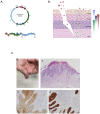Viruses and Skin Cancer
- PMID: 34065594
- PMCID: PMC8161099
- DOI: 10.3390/ijms22105399
Viruses and Skin Cancer
Abstract
Advances in virology and skin cancer over recent decades have produced achievements that have been recognized not only in the field of dermatology, but also in other areas of medicine. They have modified the therapeutic and preventive solutions that can be offered to some patients and represent a significant step forward in our knowledge of the biology of skin cancer. In this paper, we review the viral agents responsible for different types of skin cancer, especially for solid skin tumors. We focus on human papillomavirus and squamous cell cancers, Merkel cell polyomavirus and Merkel cell carcinoma, and human herpesvirus 8 and Kaposi's sarcoma.
Keywords: HPV; Kaposi’s sarcoma; Merkel cell carcinoma; cervical cancer; cutaneous squamous cell carcinoma.
Conflict of interest statement
The authors declare no conflict of interest.
Figures



References
Publication types
MeSH terms
Substances
Grants and funding
LinkOut - more resources
Full Text Sources
Medical

